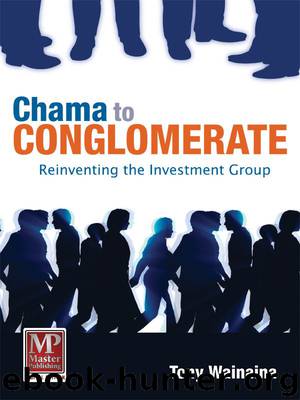Chama to Conglomerate by Tony Wainaina

Author:Tony Wainaina
Language: eng
Format: epub
Publisher: Tony Wainaina
Published: 2013-03-15T00:00:00+00:00
8. Management of Your Investment Group
Opportunity is missed by most people because it’s dressed in overalls and looks like work.—Thomas Edison
THIS ENTAILS DECISION-MAKING, DEVELOPMENT and implementation of strategy and policies, and the execution of investment transactions. Management is the game changer; the function that separates the socially oriented, regressive, dysfunctional investment clubs from the serious, business-oriented, aspirational, progressive investment holding companies. It is also the function that investment group members do not have the time and expertise to undertake full-time and effectively. It cannot be a part-time function. No successful company, anywhere and in any industry has ever succeeded by adopting part-time management.
The following are key components of the management function in investment groups:
• investment portfolio management,
• sourcing good quality investments,
• performing high-level due diligence,
• professional service providers,
• preparation for board/committee meetings,
• positioning the group as a preferred investment partner,
• implementing the strategic plan, and
• communication.
Investment Portfolio Management
An investment portfolio is defined as a collection of investments held by an individual or organisation. Earlier on we discussed the very important process of having all the investment group members develop and approve a strategic plan. Part of the strategic planning process involves developing a diversified strategic investment portfolio(SIP). This is designed to maximise your group’s returns on a range of investments or asset classes [3], and to make sure that when investing in these assets, the following have been taken into consideration:
1. The riskiness of the investments: high-risk investments give high returns and low-risk investments give low returns. See Figure 6 for an illustration of the risk/return trade-off. Do you have a combination of high and low risk return investments that should give the overall portfolio a balanced risk profile?
2. The tenor of the investment (the length of time before the investment realises a return): the decision on how long to hold on to your investment depends on a number of factors, such as your targeted return on the investment, whether you have invested in a start-up or in a mature company, and the age profile of the investment group members. Does your portfolio have a combination of short-term and long-term investments?
3. The attractiveness of the sector the investment belongs to: land belongs to the property sector; processing and packaging tea belongs to the agribusiness sector; hair salons belong to the personal care/service sector. Which of these sectors is growing rapidly or slowing down?
4. The attractiveness of the location the investment is in: is the investment in a politically and economically stable country with young, emerging industries, or not?
5. The liquidity of the investment: once the investment is made can you convert it back into cash immediately (liquid), or do you have to wait for several months to do so (illiquid)?
The investment group should aim to build and maintain a portfolio that has asset classes that have been acquired with the above considerations in mind. This diversified portfolio approach reduces the risk of one failed investment affecting the entire portfolio negatively. Table 5 gives an example of the range of investments
Download
This site does not store any files on its server. We only index and link to content provided by other sites. Please contact the content providers to delete copyright contents if any and email us, we'll remove relevant links or contents immediately.
The Black Swan by Nassim Nicholas Taleb(6761)
Bad Blood by John Carreyrou(6271)
Pioneering Portfolio Management by David F. Swensen(6078)
Millionaire: The Philanderer, Gambler, and Duelist Who Invented Modern Finance by Janet Gleeson(4089)
Skin in the Game by Nassim Nicholas Taleb(3965)
The Money Culture by Michael Lewis(3843)
Bullshit Jobs by David Graeber(3826)
Skin in the Game: Hidden Asymmetries in Daily Life by Nassim Nicholas Taleb(3720)
The Wisdom of Finance by Mihir Desai(3523)
Blockchain Basics by Daniel Drescher(3327)
Liar's Poker by Michael Lewis(3220)
The Intelligent Investor by Benjamin Graham Jason Zweig(2930)
Hands-On Machine Learning for Algorithmic Trading by Stefan Jansen(2925)
Mastering Bitcoin: Programming the Open Blockchain by Andreas M. Antonopoulos(2890)
Fooled by Randomness: The Hidden Role of Chance in Life and in the Markets by Nassim Nicholas Taleb(2860)
Investing For Dummies by Eric Tyson(2789)
The Power of Broke by Daymond John(2769)
Market Wizards by Jack D. Schwager(2538)
Zero Hour by Harry S. Dent Jr. & Andrew Pancholi(2531)
